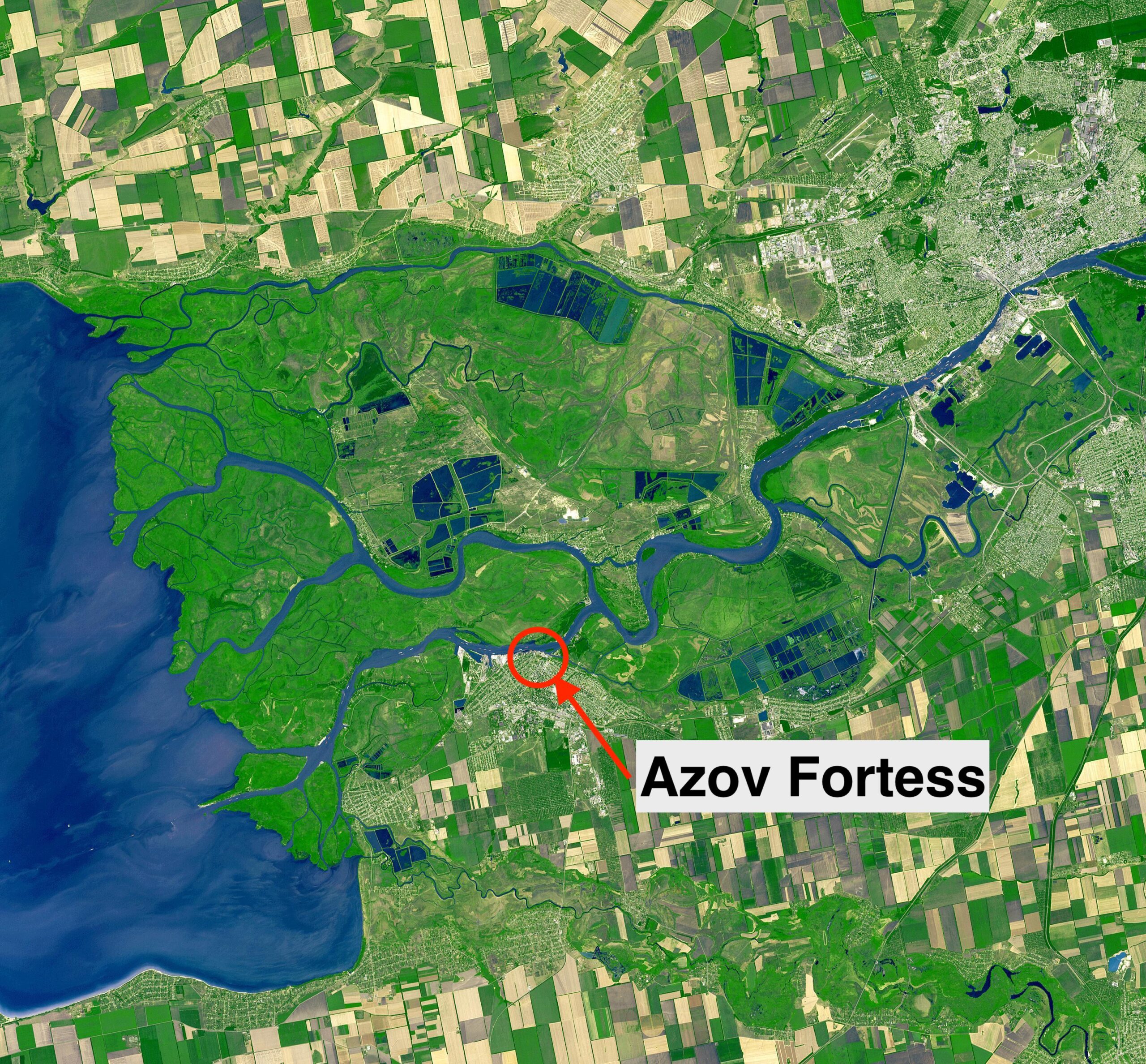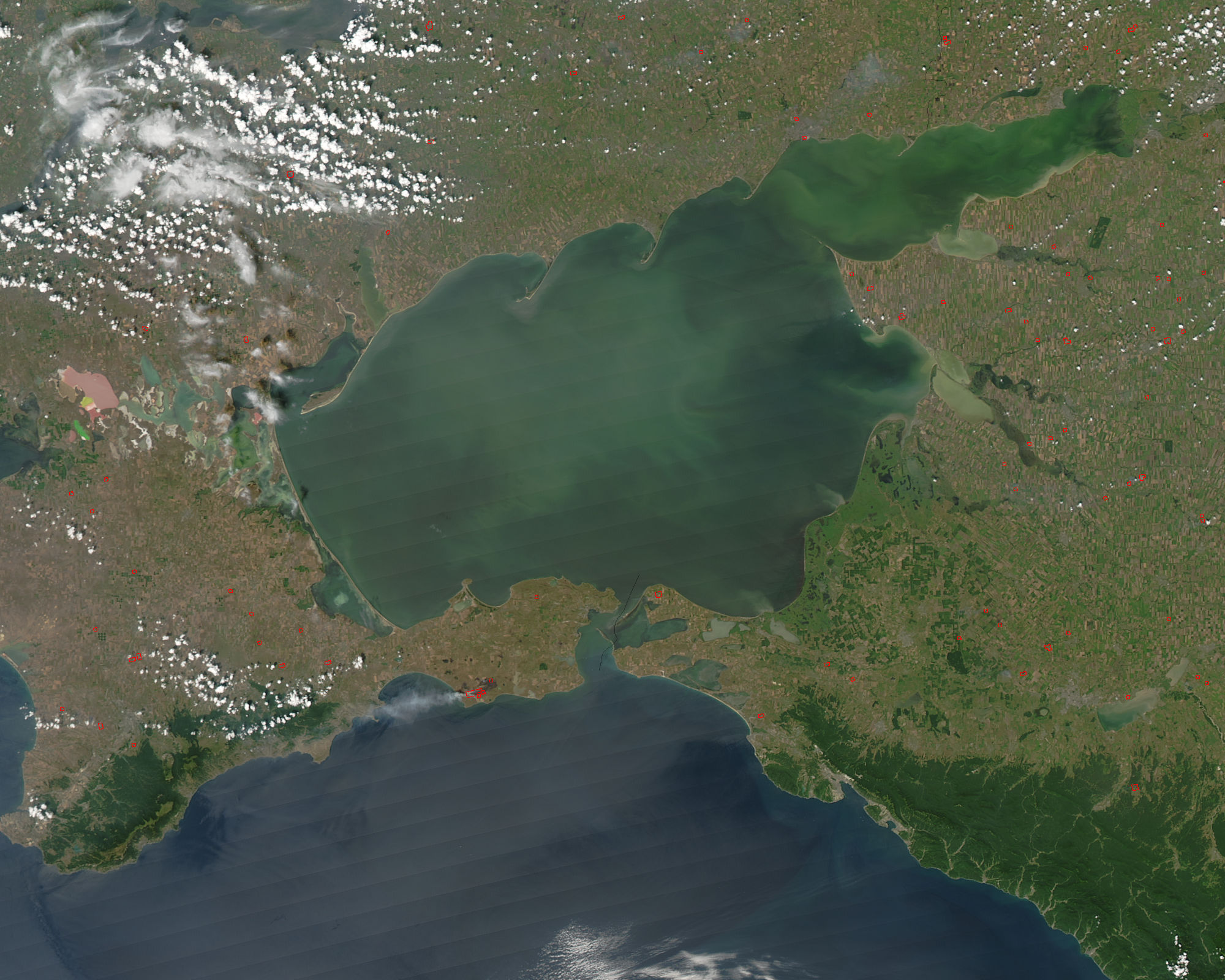The Azov Sea: A Jewel Amongst Seas—10 Reasons Why It’s Extraordinary
Introduction
The Azov Sea is located in eastern Europe, between Russia and Ukraine. There are several characteristics that make it a unique body of water. In this article, we explore them to understand why.

General information
The Sea of Azov gets its name from the ancient Azov fortress located on the Don River. The area of the sea is approximately 39,000 sq. km. (15,000 sq. miles), with a coastline that stretches across 2300 kilometers (1,400 miles).
Most of the sea’s north coast is in Ukraine, with the remaining north coast and east coast being in Russia. On the west, we have the Crimean Peninsula, and on the south, the sea is connected to the Black Sea through the Kerch Strait.
The sea lies in the transitional zone between the steppe and forest-steppe ecosystems. This allows for greater biodiversity, as we shall see in a subsequent section.

The basin of the Don river flowing into the Azov sea from the east with the Azov fortress’ location marked
The basin of the Don river flowing into the Azov sea from the east with the Azov fortress’ location marked
In this article, we shall bring to you hundreds of facts under relevant subheadings to give a complete overview of what makes the Azov Sea truly a gem amongst seas. Let’s begin with a unique fact.
1. The Azov Sea is the shallowest sea in the world
The Azov Sea is renowned as the shallowest sea in the world. It has an average depth of only 7 meters (23 feet), with a maximum depth of only about 14 meters (46 feet).
Over the centuries, the sea has undergone many changes in its size and shape because of water level fluctuations. Because of the low water levels, the Sea of Azov has distinct navigation routes marked by navigational aids and lighthouses to ensure safe passage for watercraft.
The sea’s tides are also relatively low and are affected by the Black Sea and the shape of its coastline.
2. The Azov Sea has an enviable location
The Azov Sea has a brilliant location. Being between the tropics and the polar regions allows it to have a continental climate with distinctly different seasons throughout the year.
On one hand, this leads to the sea freezing over during winter, with the ice sheets reaching a thickness of up to 70 cm (28 inches) due to subzero temperatures. On the other hand, summer temperatures can reach up to 40°C (77°F).
The coast is freckled with fishing villages and dainty resort towns. They offer peaceful and tranquil landscapes, serving as a place of relaxation and retreat for tourists and locals alike.

Azov sea beach along Makarova Street in Berdyansk
The impressive sunset over the sea attracts photographers and moviemakers alike. Many TV shows and movies have had the Azov Sea as a backdrop. Since we are on the topic of location, let us also discuss the various landscapes the sea has to offer.
3. The Azov Sea has many diverse landscapes to offer
The Azov Sea features many different landscapes all along its coast. Most areas sport wide sandy beaches, coastal dunes, and sandbars.
There are also incredible geological formations, namely the Don Delta and the Taman Peninsula, that appeal to geologists and nature enthusiasts.
The northern coast has marshes and wetlands that house specific flora and fauna. They also work as natural filters that improve the water quality and, through it, the overall health of the ecosystem.
On the western coast, we have lagoons and salt marshes known as Syvash. An interesting point to note about the Syvash is that they are regularly fed saltwater from the sea, but as the water from these lagoons evaporates, it leaves behind a hypersaline environment. Thus, on one side we have the low-salinity water of the Azov, and on the other side we have the hypersaline waters of the Syvash.
One of the most spectacular geographical formations that the Azov Sea has to offer is the spit. Spits are narrow, long landmasses that jut out of the mainland into the sea. The spits make very attractive tourist destinations.
The sea has at least 13 major spits and many minor spits. The Arabat spit is the longest in the world at 112 km and arguably one of the most beautiful.
Underwater, the Azov Sea has features such as ridges, canyons, forests, and sandbanks.
4. The Sea of Azov has a unique pink color
We spoke about the hypersaline lagoons in the Sea of Azov in the previous section. These lagoons are perfect for the growth of a special algae known as Dunaliella salina.

Dunaliella salina thrives in hypersaline regions. It contains a pink pigment that makes the water appear pink. Thus, the entire water body takes on a unique pink color that is mesmerizing to behold.
5. The second-least salty sea in the world
The Sea of Azov has a low salinity of 1 to 1.2 g per 100 g. This is only second to the Baltic Sea, which has a salinity of 0.8 to 1 g. The salinity levels are influenced by the contrasting freshwater and saltwater inflows from rivers and the Black Sea, respectively.
The low salinity allows the Azov Sea to have a peculiar mix of marine and freshwater species. The level of the sea also varies during the year depending on factors such as rainfall, evaporation, and inflow from rivers.
6. Healthy biodiversity
The Sea of Azov has one of the most biodiverse ecosystems. When it comes to flora, the Azov Sea and its surrounding area have many endemic and rare plant species.
The sea’s waters are warm and nutrient-rich, supporting diverse marine vegetation such as reeds, seaweed, grasses, and aquatic plants. This, in turn, supports many fish species throughout the food chain.
The sea contains over 80 fish species, such as mullet, flounder, bottlenose dolphin, and Russian sturgeon. It also has deep-sea species in its underwater canyons. The Azov Sea also shelters many mollusks, including the native Azov Fimbria snail.
 The endangered Russian Sturgeon
The endangered Russian Sturgeon
The sandy areas and shallow waters harbor crustaceans such as crabs and shrimp. The beaches are also nesting sites for many sea turtles, including the endangered loggerhead turtle.
When it comes to birds, the Azov Sea is an important habitat for cormorants, herons, and pelicans. The sea is also an important stopover site for migratory birds such as geese, gulls, ducks, sandpipers, and terns. Migratory birds rest and feed in the sea’s wetlands and deltas along the East Atlantic Flyway.
The sea’s surrounding region also has several protected areas and nature reserves, such as the Azov-Syvash National Nature Park, to conserve its unique biodiversity and ecosystem.
7. Rich cultural heritage
Because of its unique features, the Azov Sea has a rich cultural heritage. Its long history goes back to ancient times. The region has medieval fortresses, primitive ruins, and historic villages that indicate inhabitation for several thousand years.
The archaeological excavation sites frequently reveal artifacts from civilizations dating all the way back to the time of nomadic tribes. This is why, even today, the area has high ethnic diversity.
The Greeks knew the Azov Sea as “Maeotis,” whereas the Romans referred to it as “Palus Maeotis.”
Over the years, the region has developed unique cultural traditions and a lively folklore. It has many traditional crafts, such as pottery, woodwork, folk music, and weaving, with peculiar styles. These crafts are also associated with cultural events and local festivals.
The Azov Sea also finds many mentions in the literature of the region. It has been inspiring musicians, writers, and other artists for centuries.
8. Riveting military history
The tactical location and economic importance of the Azov Sea have made it a site of military significance throughout history.
As a trade route connecting Europe with Asia, the sea witnessed many important historical events, such as the Mongol invasions and the Crimean War. During the Crimean War in 1855, the naval battle of Taganrog was fought here.

There are many underwater sites in the Sea of Azov containing ancient relics and shipwrecks from different times in history.
9. A very popular tourist destination
The Azov Sea region is also popular with tourists. It provides them with a wide range of wellness and relaxation sources, such as spas and mud baths. The region’s muds have therapeutic and healing properties.
The warm waters and slow currents enable swimming and other water-based activities such as kiteboarding, windsurfing, yachting, and sailing. The seacoast has many marinas and sailing clubs.
The sea also has an abundant fish population to enable recreational and commercial fishing. The clear, sandy bottoms facilitate activities such as snorkeling and scuba diving.
The seacoast is also popular for camping and other recreational activities such as birdwatching (migratory birds), waterfowl hunting, and game hunting.
10. Economic importance
The Sea of Azov plays an important role in the region’s economy. The ports of Taganrog, Berdyansk, and Mariupol are important trade centers and vital to economic development.
The sea itself supports the fishing industry through its abundant resources. It contains many commercially important fish and crustaceans that provide employment to coastal communities. The waters are also used for aquaculture activities and oyster cultivation.
The sea also sports high hydrocarbon reserves that attract exploration and extraction activities.
The Azov Sea also enriches the surrounding regions through irrigation systems. The region has high agricultural activity because of the fertile plains. The climate and the soil support crops such as sunflowers, wheat, and vegetables.
Current scenario
Many scientific studies have been carried out in recent years in the Azov Sea. Most of these focus on the sea’s marine life, ecology, and geology. They have shown the impact of climate change on the coastal ecosystem. Environmental changes have been observed due to algal blooms and eutrophication.
The ecosystem has also undergone degradation due to overfishing, pollution, and war. For instance, the establishment of Meotide National Nature Park led to an explosion in the population of rare wetland birds. The diversity disappeared almost immediately in 2015, when the war came to Kryva Kosa Spit.
It is the mutual responsibility of all surrounding nations to ensure that the environment is not adversely affected by man-made causes as far as possible to maintain the fine balance of the ecosystem.
FAQ
Where is the Sea of Azov located on a map?
The Azov Sea is located to the north of the Black Sea. The sea lies west and south of Russia, south of Ukraine and to the east of the hotly contested Crimea peninsula.
Who controls the Azov Sea?
The Azov Sea is shared territory between Ukraine and Russia as per the Treaty of 2003. But as of late, Russia has been dominating the Azov sea through military presence across the Azov Sea and the Kerch Strait.
Is the Sea of Azov connected to the Black Sea?
The Sea of Azov is connected to the Black Sea through the Kerch Strait. The Sea connects to the Atlantic ocean through the Black, Marmara, Aegean and the Mediterranean sea.
Which countries border the Azov Sea?
Russia and Ukraine border the Azov Sea.
Which are the major Azov Sea ports?
The Port of Mariupol (Ukraine) is the largest port in the Azov Sea. Other ports are Berdiansk (Ukraine), Taganrog (Russia), and Kerch (Crimea).
How much gas reserves are in the Azov Sea?
The Azov Sea has gas reserves of about 14 million cubic metres, which is less than 0.002% of Ukraine’s total gas reserves of about 820 billion cubic metres.
Is the Sea of Azov international waters?
As per the treaty of 2003, the Sea of Azov is an internal sea shared between Ukraine and Russia. Both countries have free access to the Sea and the Kerch Strait.

Leave a Reply